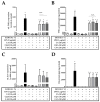Amaranth's 2-Caffeoylisocitric Acid-An Anti-Inflammatory Caffeic Acid Derivative That Impairs NF-κB Signaling in LPS-Challenged RAW 264.7 Macrophages
- PMID: 30866427
- PMCID: PMC6471825
- DOI: 10.3390/nu11030571
Amaranth's 2-Caffeoylisocitric Acid-An Anti-Inflammatory Caffeic Acid Derivative That Impairs NF-κB Signaling in LPS-Challenged RAW 264.7 Macrophages
Abstract
For centuries, Amaranthus sp. were used as food, ornamentals, and medication. Molecular mechanisms, explaining the health beneficial properties of amaranth, are not yet understood, but have been attributed to secondary metabolites, such as phenolic compounds. One of the most abundant phenolic compounds in amaranth leaves is 2-caffeoylisocitric acid (C-IA) and regarding food occurrence, C-IA is exclusively found in various amaranth species. In the present study, the anti-inflammatory activity of C-IA, chlorogenic acid, and caffeic acid in LPS-challenged macrophages (RAW 264.7) has been investigated and cellular contents of the caffeic acid derivatives (CADs) were quantified in the cells and media. The CADs were quantified in the cell lysates in nanomolar concentrations, indicating a cellular uptake. Treatment of LPS-challenged RAW 264.7 cells with 10 µM of CADs counteracted the LPS effects and led to significantly lower mRNA and protein levels of inducible nitric oxide synthase, tumor necrosis factor alpha, and interleukin 6, by directly decreasing the translocation of the nuclear factor κB/Rel-like containing protein 65 into the nucleus. This work provides new insights into the molecular mechanisms that attribute to amaranth's anti-inflammatory properties and highlights C-IA's potential as a health-beneficial compound for future research.
Keywords: NF-κB; RAW 264.7 macrophages; amaranth; caffeic acid derivatives; inflammation.
Conflict of interest statement
The authors declare that they have no conflict of interest.
Figures




References
-
- Das S. Amaranthus: A Promising Crop of Future. Springer; Berlin/Heidelberg, Germany: 2016.
-
- Schröter D., Baldermann S., Schreiner M., Witzel K., Maul R., Rohn S., Neugart S. Natural diversity of hydroxycinnamic acid derivatives, flavonoid glycosides, carotenoids and chlorophylls in leaves of six different amaranth species. Food Chem. 2017 doi: 10.1016/j.foodchem.2017.11.043. - DOI - PubMed
MeSH terms
Substances
Grants and funding
LinkOut - more resources
Full Text Sources
Other Literature Sources

